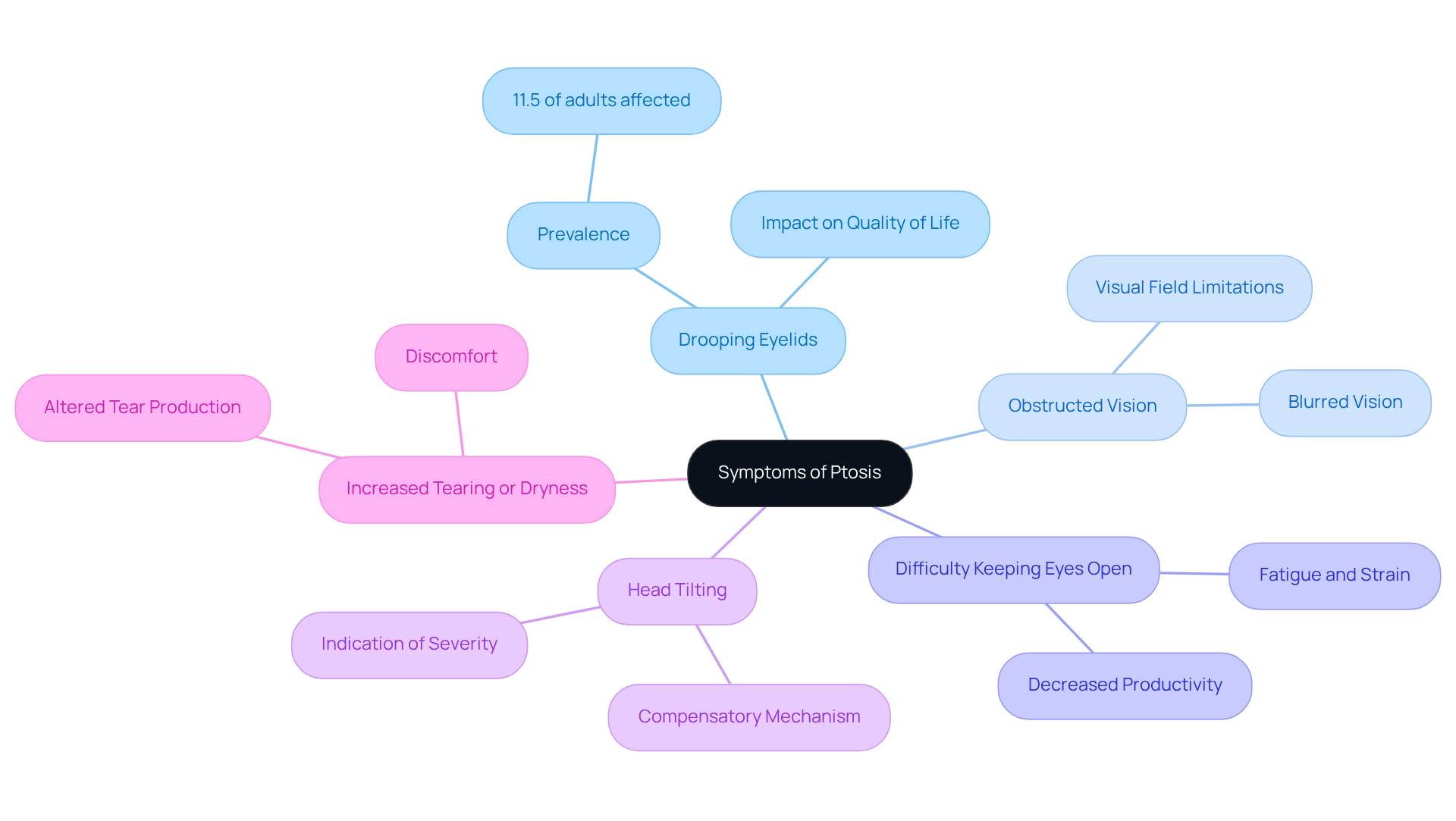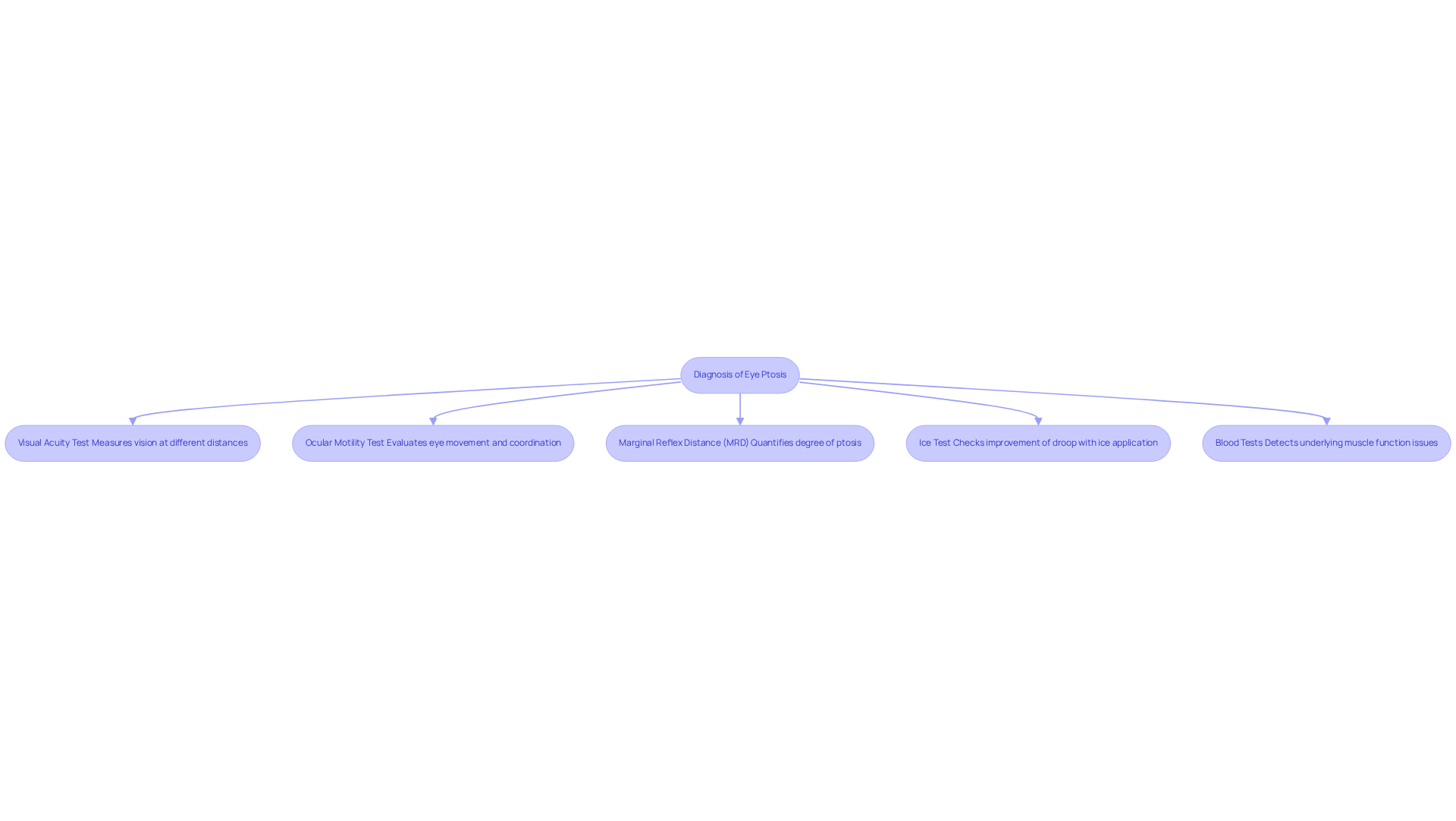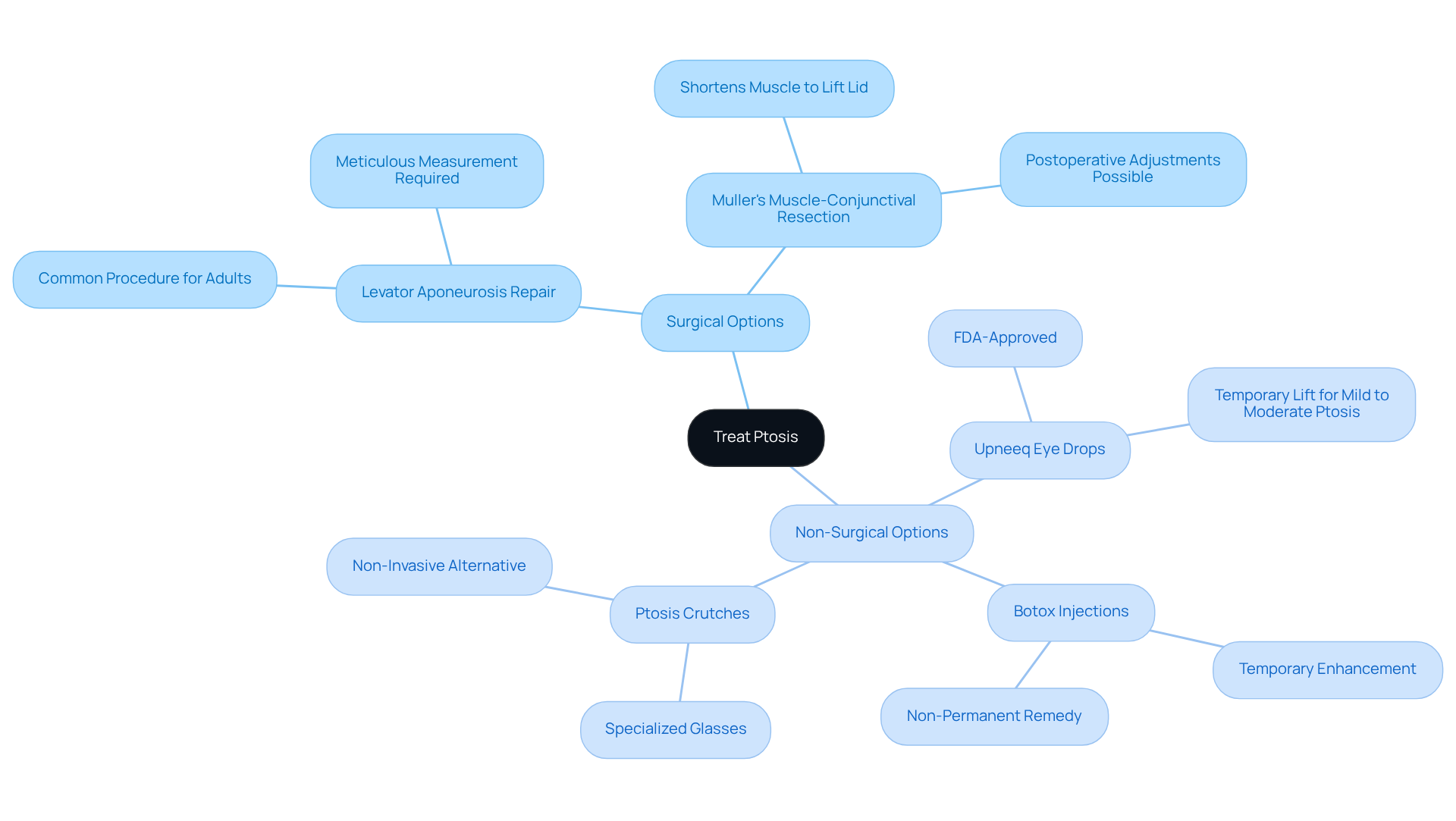Posted by: Northwest Eye in General on November 6, 2025
Overview
Eye ptosis, often referred to as droopy eyelids, can stem from congenital factors or the natural weakening of muscles as we age. We understand that this condition can significantly affect both your vision and appearance, and it’s common to feel concerned about these changes.
Recognizing the symptoms early is crucial. Seeking prompt treatment options can make a world of difference. These may include:
- Surgical interventions
- Non-invasive solutions like eye drops
We are here to help you through this process, ensuring you have the support you need to enhance your quality of life and prevent potential complications.
Remember, you’re not alone in this journey. Many have faced similar challenges and found effective ways to manage their condition. It’s important to explore your options and discuss them with a healthcare professional who can guide you toward the best solution for your needs.
Introduction
Eye ptosis, often known as droopy eyelids, is a condition that can deeply affect both vision and self-esteem. We understand that this can be particularly concerning, especially for older adults and children. It’s essential to grasp the causes, symptoms, and treatment options available for those affected.
Navigating the journey to address eye ptosis can feel overwhelming, filled with uncertainty and questions about the best course of action. What factors contribute to this condition? How can individuals effectively manage their treatment choices? It’s common to feel anxious about these questions.
By exploring these aspects, we aim to empower you to take charge of your eye health and seek the care you deserve. Remember, you’re not alone in this journey, and we are here to help you through the process.
Define Ptosis: Understanding Droopy Eyelids
Eye ptosis, commonly known as blepharoptosis, is a condition characterized by the sagging of one or both upper eyelids. We understand that this can be concerning, as it can range from a subtle droop that’s hardly noticeable to a more pronounced sag that may obscure your vision. The levator palpebrae superioris muscle is responsible for lifting the eyelid, and when this muscle weakens or is injured, drooping can occur. Recognizing eye ptosis is crucial, as this condition can significantly impact both your vision and appearance.
The prevalence of eyelid droop is noteworthy. Studies indicate that around 11.5% of individuals aged 50 and older in the UK experience this condition. In children, the prevalence can be even higher, with congenital cases making up a significant portion. For example, research shows that 73.4% of patients over 50 had ptosis in at least one eye. This highlights the importance of regular eye examinations to identify and address any issues early on.
Real-life stories of successful droopy lid corrections through surgery can be quite reassuring. Surgical procedures, which typically last between 30 to 60 minutes, involve reattaching or shortening the levator muscle. Remarkably, about 95% of patients report satisfactory results. However, it’s important to note that around 5% may need additional touch-up surgeries due to complications like swelling affecting eyelid position.
Recent research emphasizes the need for careful postoperative management to ensure the best outcomes. A study published in the Journal of Clinical Medicine explored the link between eyelid droop improvement and immediate postoperative lagophthalmos. While most patients see significant enhancement, some may face challenges that require further attention.
Experts remind us that “Inadequate care, such as rubbing or improper handling of the operated eyes, can compromise the maintenance of the desired surgical outcomes.” This underscores the importance of patient education and following postoperative care guidelines to achieve the best results. Overall, understanding eye ptosis not only aids in recognizing its implications but also empowers you to seek prompt and effective treatment options. We are here to help you through this process.

Explore Causes of Ptosis: Pediatric vs. Adult Factors
Eye ptosis, also known as drooping of the eyelid, can be a concern for many, and it’s important to understand that it comes in two primary types: congenital and acquired. Each type has its own characteristics and causes, and we’re here to help you navigate through this.
Eye ptosis is a condition that is present at birth and often arises from developmental issues with the levator muscle, which is responsible for lifting the eyelid. This condition can be linked to genetic factors, and studies show that congenital eyelid drooping affects about 1.8 to 14.1 per 1,000 individuals in the general population. We understand that learning about this can be overwhelming, but knowing the facts can help you feel more in control.
On the other hand, acquired ptosis typically appears in adults and can stem from various factors, including:
- Aging: As we age, the levator muscle may weaken, leading to what’s known as involutional or aponeurotic ptosis.
- Neurological disorders such as myasthenia gravis and Horner’s syndrome can affect the nerves or tissues involved in eye movement, which can result in eye ptosis.
- Any trauma that causes damage to the muscles or nerves around the eye can affect its function and lead to eye ptosis.
- Surgical Complications: Previous eye surgeries might inadvertently alter eyelid mechanics, resulting in eye ptosis and causing drooping.
Recent studies highlight that congenital eyelid droop occurs in about 1 in 842 live births, while the incidence of acquired eyelid droop in adults varies, with reports indicating rates between 4.7% and 13.5% across different populations. We understand that these differences can be significant when considering treatment options. Early intervention in congenital cases is often crucial to prevent complications like amblyopia, while a tailored approach may be necessary for acquired eye ptosis based on its underlying cause.
Remember, you’re not alone in this journey. We are here to help you through the process and provide the support you need.

Identify Symptoms of Ptosis: Recognizing the Signs
Recognizing the symptoms of eye ptosis is crucial for timely diagnosis and effective treatment. We understand that noticing changes in your eyelids can be concerning, and being aware of these signs can help you take the next steps toward care. Common signs include:
- Drooping Eyelids: This is the most prominent symptom, often affecting one or both eyes. Approximately 11.5% of adults encounter sagging eyelids, which can greatly affect their quality of life.
- Obstructed Vision: In severe cases, drooping eyelids can block part of the visual field, leading to difficulties in daily activities. It’s common to feel frustrated when your vision is impaired, and research suggests that this can limit peripheral vision, making it crucial to tackle this issue. Additionally, blurred vision can be a sign of various ailments, including uncorrected refractive errors, which may accompany eye ptosis.
- Difficulty Keeping Eyes Open: Eye ptosis can make you feel fatigued or strained as you struggle to raise your eyelids, leading to discomfort and decreased productivity. We understand how this can impact your daily life.
- Head Tilting: To compensate for the droop, some individuals may tilt their heads back. This common adjustment can indicate the seriousness of the issue, and it’s important to pay attention to these changes.
- Increased Tearing or Dryness: Changes in tear production may occur due to the altered eyelid position, leading to either excessive tearing or dryness.
Being aware of these symptoms can prompt you to seek evaluation from an eye care professional. As noted by experts, timely intervention can lead to significant improvements in both vision and overall well-being. We want you to know that untreated symptoms can lead to serious health complications. Therefore, it is vital for you to recognize these signs early and schedule an appointment with a Northwest Eye doctor for a thorough evaluation. We are here to help you through this process.

Diagnose Ptosis: Tests and Evaluations
Diagnosing eye ptosis can feel overwhelming, but we’re here to guide you through the process. A thorough evaluation by an eye care professional is essential for accurately determining your condition, particularly if eye ptosis is present, as they will use various tests and assessments. Here are some key diagnostic methods that may be employed:
- Visual Acuity Test: This test measures how well you can see at different distances, helping to identify any vision impairment associated with ptosis.
- Ocular Motility Test: This assessment evaluates your eye movement and coordination, which can reveal underlying neuromuscular issues.
- Marginal Reflex Distance (MRD): This measurement quantifies the degree of ptosis by assessing the distance between the upper lid margin and the corneal light reflex, providing a precise evaluation of droop.
- Ice Test: In this procedure, ice is applied to the eyelid to see if the droop improves, which can indicate conditions like myasthenia gravis.
- Blood Tests: These may be conducted to detect any underlying issues that could affect muscle function, such as autoimmune disorders.
These assessments are crucial for understanding the severity of eye ptosis and guiding appropriate treatment options. We understand that precise diagnosis is vital, as misdiagnosis can occur, especially when symptoms overlap with other conditions. Symptoms like blurred vision can be linked to various eye diseases, making it important to seek professional medical help.
Effective diagnosis and treatment strategies often involve a combination of these assessments, providing a comprehensive approach to managing your condition successfully. Remember, you’re not alone in this journey; we are here to help you through every step.

Treat Ptosis: Surgical and Non-Surgical Options
Treatment for eye ptosis can feel overwhelming, but understanding your options can help alleviate your concerns. The right approach depends on the severity of your condition and its underlying causes. Here are some options to consider:
-
Surgical Options:
- Levator Aponeurosis Repair: This is the most common surgical procedure for adults. It tightens the levator muscle, effectively lifting the eyelid. We understand that meticulous measurement during this procedure is crucial for achieving optimal results.
- Muller’s Muscle-Conjunctival Resection: This procedure shortens the muscle to lift the upper lid, offering a practical solution for specific drooping cases. If needed, postoperative adjustments can be made within a week to correct any overcorrection in levator advancement.
-
Non-Surgical Options:
- Upneeq Eye Drops: These FDA-approved drops provide a temporary lift for patients with mild to moderate ptosis, enhancing eyelid position without invasive procedures.
- Botox Injections: In certain cases, Botox can be used to temporarily enhance the position of the eyelids, providing a non-permanent remedy.
- Ptosis Crutches: These specialized glasses assist in holding the eyelids up without the need for surgery, offering a practical alternative for patients.
Selecting the appropriate treatment is a journey that requires a thorough discussion with an eye care professional. They can help you weigh the benefits and risks associated with each option. It’s important to note that studies show 13.7% of blepharoplasty candidates had undiagnosed eyelid droop, with 85.5% of these instances categorized as mild. Additionally, eyebrow asymmetry can be a crucial sign of undiagnosed eyelid droop, highlighting the necessity of thorough assessments before making treatment choices.
Acquired eye ptosis can have negative cosmetic and functional effects, which further emphasizes the need for timely intervention. Remember, we are here to help you through this process.

Conclusion
Understanding eye ptosis is crucial for recognizing how it can affect both vision and appearance. This condition, which involves the drooping of one or both eyelids, can stem from various causes. These include congenital factors in children and age-related changes or neurological disorders in adults. We understand that learning about ptosis can feel overwhelming, but gaining insight into this condition allows individuals to take meaningful steps toward seeking appropriate care.
Throughout this article, we’ve explored key aspects of eye ptosis, including its symptoms, diagnostic methods, and treatment options. Recognizing common signs—like drooping eyelids, obstructed vision, and difficulty keeping your eyes open—can prompt timely evaluations by eye care professionals. Diagnostic tests are essential for determining the severity and underlying causes. Treatment options vary widely, ranging from surgical interventions to non-invasive solutions like eye drops and specialized glasses.
Ultimately, being informed about eye ptosis empowers you to address this condition effectively. Whether it’s through early diagnosis or exploring various treatment avenues, taking action can lead to significant improvements in both your quality of life and visual function. We encourage you to stay vigilant about your eye health and seek professional guidance. Remember, reaching out for help can make a substantial difference in managing eye ptosis and enhancing your overall well-being.
Frequently Asked Questions
What is eye ptosis?
Eye ptosis, also known as blepharoptosis, is a condition characterized by the sagging of one or both upper eyelids, which can range from a subtle droop to a more pronounced sag that may obscure vision.
What causes eye ptosis?
Eye ptosis can be classified into two types: congenital, which is present at birth due to developmental issues with the levator muscle, and acquired, which typically occurs in adults due to factors such as aging, neurological disorders, trauma, or surgical complications.
How prevalent is eye ptosis?
Studies indicate that approximately 11.5% of individuals aged 50 and older in the UK experience eye ptosis. In children, the prevalence can be higher, with congenital cases affecting about 1.8 to 14.1 per 1,000 individuals.
What surgical options are available for correcting eye ptosis?
Surgical procedures for correcting eye ptosis typically last between 30 to 60 minutes and involve reattaching or shortening the levator muscle. About 95% of patients report satisfactory results after surgery.
Are there any risks or complications associated with ptosis surgery?
While most patients achieve good outcomes, around 5% may require additional touch-up surgeries due to complications such as swelling affecting eyelid position.
What is the importance of postoperative care after ptosis surgery?
Proper postoperative care is crucial for maintaining surgical outcomes. Inadequate care, such as rubbing or improper handling of the operated eyes, can compromise results, highlighting the need for patient education on care guidelines.
How does congenital ptosis differ from acquired ptosis?
Congenital ptosis is present at birth and often linked to genetic factors, while acquired ptosis occurs in adults and can result from aging, neurological disorders, trauma, or complications from previous surgeries.
What should be considered for treatment options for eye ptosis?
Early intervention is often crucial in congenital cases to prevent complications like amblyopia, while a tailored approach is necessary for acquired ptosis based on its underlying cause.






